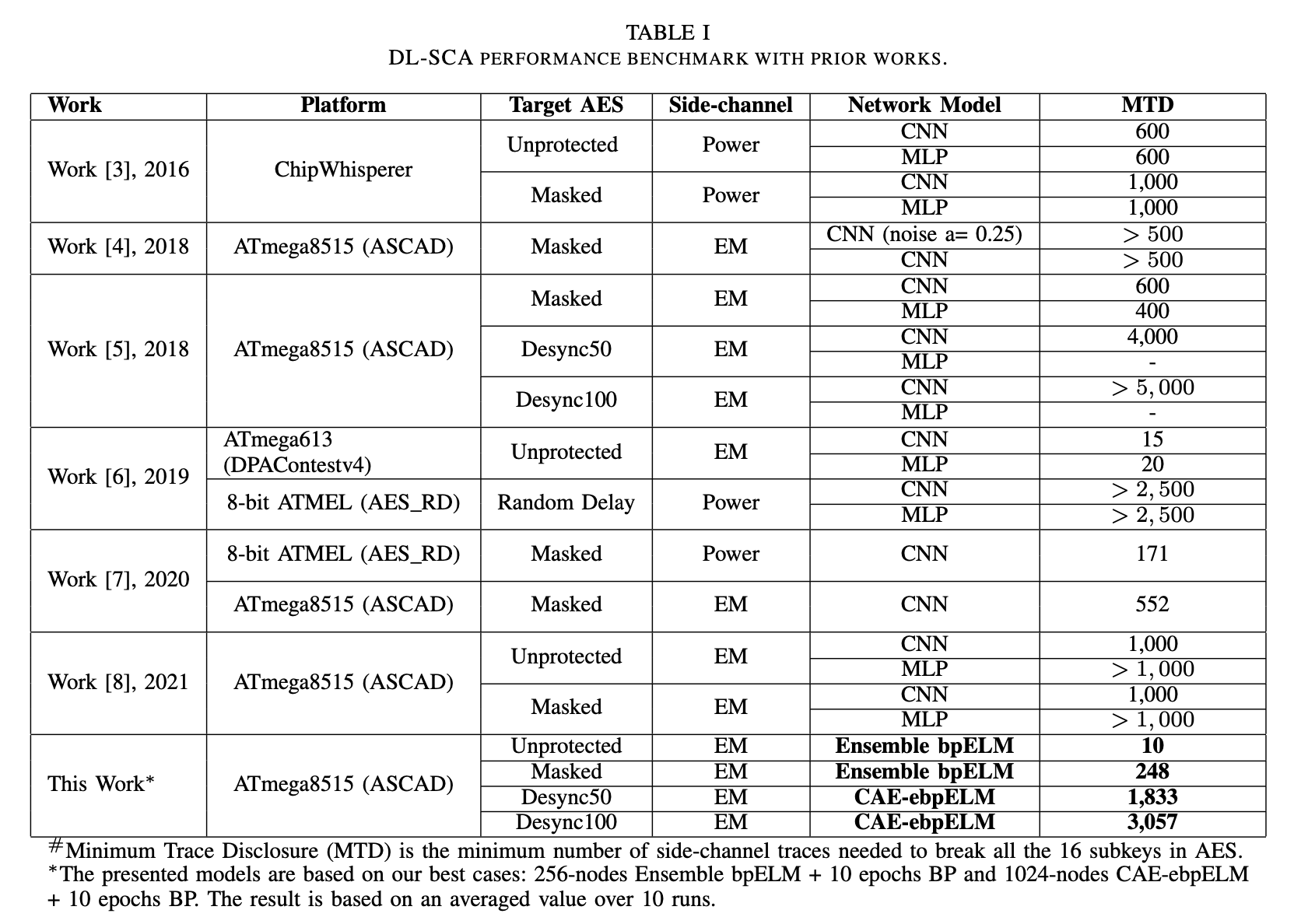Ensemble-bpELM & CAE-ebpELM
Two fast training profiled DL-SCA models against synchronized or de-synchronized masked AES. (Don't forget hitting
Check this article for details: A Backpropagation Extreme Learning Machine Approach to Fast Training Neural Network-Based Side-Channel Attack (AsianHOST2021) DOI: 10.1109/AsianHOST53231.2021.9699677.
Authors: Xuyang Huang, Ming Ming Wong, Anh Tuan Do, Wang Ling Goh.
Institute of Microelectronics (IME), A*STAR Singapore, Singapore.
School of Electrical and Electronic Engineering, Nanyang Technological University, Singapore.
How to use
Download datasets
ASCAD: page link
Attack
For Ensemble-bpELM (aligned traces): Please refer to main_ebpelm.py.
For CAE-ebpELM (misaligned traces): Please refer to train_cae.py for training CAE, main_cae_ebpelm.py for attack.
Abstract
This work presented new Deep learning Side-channel Attack (DL-SCA) models that are based on Extreme Learning Machine (ELM). Unlike the conventional iterative backpropagation method, ELM is a fast learning algorithm that computes the trainable weights within a single iteration. Two models (Ensemble bpELM and CAE-ebpELM) are designed to perform SCA on AES with Boolean masking and desynchronization/jittering. The best models for both attack tasks can be trained 27× faster than MLP and 5× faster than CNN respectively. Verified and validated using ASCAD dataset, our models successfully recover all 16 subkeys using approximately 3K traces in the worst case scenario.
Requirements
Python >= 3.7, Tensorflow >= 2.1
Performance
Ensemble-bpELM
Best case: 256-nodes Ensemble bpELM with 10 epochs backpropagation.
Attacking Capability
The minimum traces to disclosure (MTD) for all 16 subkeys on ASCAD is 248 traces.
Training Efficiency
Our best-case Ensemble bpELM model only requires 462 sec training time which is 27x faster than MLP in our reproduction of [1].
CAE-ebpELM
Best case: 1024-nodes CAE-ebpELM with 10 epochs backpropagation.
Attacking Capability
For desynchronized AES test case, our best model, 1024-nodes CAE-ebpELM with 10 epochs of backpropagation managed to recover all the 16 subkeys with MTD of 1,833 traces for Desync50 dataset and MTD of 3,057 traces for Desync100 dataset.
Training Efficiency
1024-nodes CAE-ebpELM model requires a total of 86 min where 30 min is for the auto-encoder training. Meanwhile, in CNN, the total training time is 480 min or approximately 30min/subkey (reproduction from [1]).
[1] E. Prouff, R. Strullu, R. Benadjila, E. Cagli, and C. Canovas, “Study of deep learning techniques for side-channel analysis and introduction to ASCAD database,” IACR Cryptol. ePrint Arch., vol. 2018, pp. 53, 2018.
Experimental Setup
Ensemble bpELM and the Ensemble bpELM part of CAE- ebpELM are trained on AMD Ryzen 5 4600U @2.1GHz CPU and 16GB RAM without GPU.
The CAE part of CAE-ebpELM, MLP and CNN models are trained on Intel Xeon @2.3 GHz and 13 GB RAM with a NVIDIA Tesla P100, 12 GB RAM.

